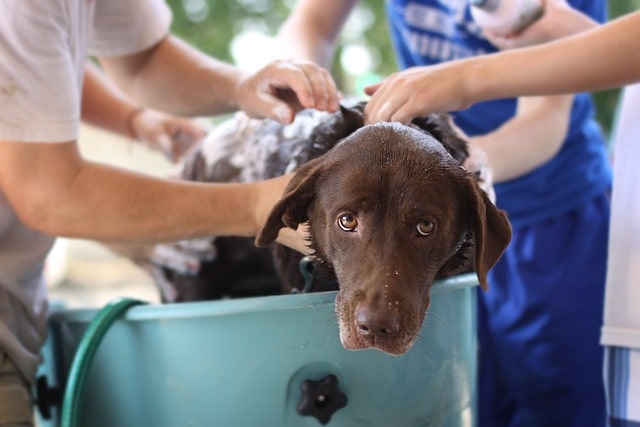Neutering is a surgical procedure that removes the reproductive organs of a male dog. It is also known as castration or sterilization. Neutering has many benefits for your dog’s health and behavior, such as reducing the risk of certain cancers, infections, and aggression.
Neutering is a common and safe procedure, but it still requires some care and attention after the surgery. One of the questions that many pet owners have is: how soon can I bathe my dog after neutering?
The answer to this question depends on several factors, such as the type of surgery, the healing process, and the bathing method. In this article, we will explain these factors and provide you with some tips and advice on how to safely bathe your dog post-neutering.
Understanding the Neutering Procedure
To understand how long after being neutered can a dog have a bath, you need to understand what happens during a neutering surgery. Neutering is usually performed under general anesthesia, meaning that your dog will be unconscious and pain-free during the operation.
The most common method of neutering is called an open castration. In this method, the veterinarian makes an incision in the scrotum and removes the testicles through the opening. The incision is then closed with sutures or surgical glue.
Another method of neutering is called closed castration. In this method, the veterinarian makes an incision in the abdomen and removes the testicles through the opening. The incision is then closed with sutures or surgical glue.
A newer method of neutering is called laparoscopic castration. In this method, the veterinarian makes one or two small incisions in the abdomen and inserts a camera and instruments through them. The testicles are then removed using a laser or a cautery device. The incisions are then closed with sutures or surgical glue.
Some pet owners worry about bathing their dogs after neutering because they are afraid of causing infection, irritation, or bleeding in the surgical site. They are also concerned about removing or damaging the sutures or glue that hold the incision together.
These are valid concerns, but they can be avoided by following some simple guidelines and precautions.
What Factors to Consider to Bath Your Dog After Neutering
When deciding when you can bathe your dog after neutering, you need to consider some factors that influence the healing process and the bathing procedure. These factors include:
- The type of surgery: Different methods of neutering have different recovery times and risks. Generally speaking, open castration has a shorter recovery time and lower risk of complications than closed or laparoscopic castration. This is because open castration involves a smaller and simpler incision than closed or laparoscopic castration.
- The type of sutures or glue: Different types of sutures or glue have different durability and dissolvability. Generally speaking, absorbable sutures or glue dissolve on their own within a few weeks and do not need to be removed by the veterinarian. Non-absorbable sutures or glue do not dissolve on their own and need to be removed by the veterinarian after 10 to 14 days.
- The type of bathing: Different types of bathing have different effects on the surgical site. Generally speaking, dry bathing (such as using wipes or dry shampoo) is safer and gentler than wet bathing (such as using water or soap). Wet bathing can cause infection, irritation, or bleeding in the surgical site if done too soon or too harshly.
When to Bath Your Dog After Neutering
Based on these factors, most veterinarians recommend waiting at least 10 to 14 days before bathing your dog after neutering. This is enough time for the surgical site to heal and for the sutures or glue to dissolve or be removed.
However, this waiting period may vary depending on the type of surgery, the type of sutures or glue, and the type of bathing. For example:
- If your dog had an open castration with absorbable sutures or glue, you may be able to bathe him sooner than 10 days, as long as you use dry bathing methods and avoid wetting or rubbing the surgical site.
- If your dog had a closed or laparoscopic castration with non-absorbable sutures or glue, you may need to wait longer than 14 days, as long as you wait for the veterinarian to remove them before wetting or rubbing the surgical site.
- If your dog had any complications or infections after neutering, you may need to wait longer than 14 days, as long as you follow your veterinarian’s instructions on how to treat them before wetting or rubbing the surgical site.
The best way to determine when you can bathe your dog after neutering is to consult your veterinarian for guidance. Your veterinarian will examine your dog’s surgical site and advise you on how long to wait and how to bathe him safely.
How to Safely Bath Your Dog Post-neutering
Once you have determined that your dog is ready to be bathed after neutering, you need to follow some safe bathing procedures to avoid harming him or his surgical site. Here are some tips on how to safely bath your dog post-neutering:
- Use dry bathing methods if possible: Dry bathing methods are safer and gentler than wet bathing methods. You can use wipes or dry shampoo to clean your dog’s coat and skin without wetting or rubbing his surgical site. You can also use a brush or a comb to remove any dirt or debris from his fur.
- Use wet bathing methods only if necessary: Wet bathing methods are riskier and harsher than dry bathing methods. You should only use water or soap to bath your dog if he is very dirty or smelly and cannot be cleaned with dry bathing methods. You should also use warm water and mild soap that are suitable for dogs and do not irritate their skin.
- Avoid wetting or rubbing the surgical site: Wetting or rubbing the surgical site can cause infection, irritation, or bleeding. You should avoid getting the surgical site wet or soapy at all costs. You should also avoid touching or scratching the surgical site with your hands or a towel. You should only gently pat the surgical site dry with a clean and soft cloth if it gets wet accidentally.
- Avoid using any products that may harm the surgical site: Some products that may harm the surgical site are alcohol, hydrogen peroxide, iodine, bleach, or other harsh chemicals. These products can cause burning, stinging, drying, or allergic reactions at the surgical site. You should only use products that are recommended by your veterinarian for wound care.
Common Concerns About Bathing Dogs After Neutering

Some common concerns that pet owners have about bathing their dogs after neutering are:
- What if my dog gets wet accidentally? If your dog gets wet accidentally after neutering, such as by rain, snow, sprinklers, pools, lakes, or other sources of water, you should not panic. You should simply dry him off as soon as possible and check his surgical site for any signs of infection, irritation, or bleeding. If you notice any problems, you should contact your veterinarian immediately.
- What if my dog gets dirty or smelly during the healing period? If your dog gets dirty or smelly during the healing period, you should try to clean him with dry bathing methods, such as using wipes or dry shampoo. You should avoid wet bathing methods, such as using water or soap, until the surgical site is fully healed and the sutures or glue are dissolved or removed. If your dog is very dirty or smelly and cannot be cleaned with dry bathing methods, you should consult your veterinarian for advice.
- What if my dog gets an infection or a complication after neutering? If your dog gets an infection or a complication after neutering, such as redness, swelling, discharge, pain, fever, or lethargy, you should seek veterinary attention as soon as possible. Your veterinarian will examine your dog’s surgical site and prescribe the appropriate treatment. You should follow your veterinarian’s instructions carefully and monitor your dog’s condition closely.
When to Consult Your Vet
The most important thing to remember when bathing your dog after neutering is to consult your veterinarian for guidance. Your veterinarian knows your dog’s medical history and condition better than anyone else. Your veterinarian can advise you on when and how to bathe your dog safely and effectively.
You should consult your veterinarian before bathing your dog after neutering if:
- You are unsure about the type of surgery, the type of sutures or glue, or the type of bathing that your dog has or needs.
- You have any questions or concerns about the healing process or the bathing procedure?
- You notice any signs of infection or complications in your dog’s surgical site.
You should also consult your veterinarian after bathing your dog after neutering if:
- You notice any changes or problems in your dog’s surgical site.
- You notice any adverse reactions or side effects in your dog’s skin or coat
- You notice any changes or problems in your dog’s behavior or health.
Your veterinarian is your best ally and resource when it comes to caring for your dog after neutering. Your veterinarian can help you ensure that your dog recovers well and stays healthy and happy.
Final Thoughts on When Can You Bathe a Dog After Neutering
Bathing your dog after neutering is a common concern for pet owners, and rightfully so. While cleanliness is essential, the healing process should be the top priority. The waiting period, typically around 10-14 days, allows your dog’s incision to heal and minimizes the risk of infection or complications.
However, it’s vital to remember that individual cases may vary. Consult with your veterinarian for specific guidance based on your dog’s health and the type of surgery performed. Pay close attention to signs of healing or any unusual symptoms, and don’t hesitate to seek professional advice if you have concerns.
Remember that love, care, and patience are your best tools in ensuring a smooth recovery for your furry friend. The bathing tub can wait a little longer; your dog’s well-being should always come first.





